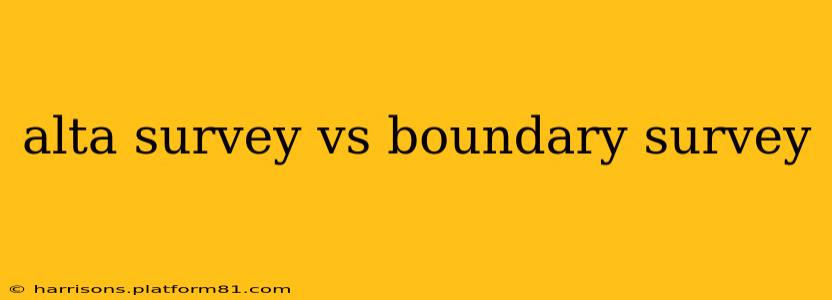Choosing the right type of land survey is crucial for various real estate transactions and development projects. Two common types are ALTA surveys and boundary surveys. While both involve determining property lines, they differ significantly in scope, detail, and purpose. This article will clarify the key distinctions between ALTA surveys and boundary surveys, helping you understand which one is appropriate for your needs.
What is a Boundary Survey?
A boundary survey is a fundamental type of land survey that establishes the precise location of your property lines. It identifies the perimeter of your land, marking its boundaries with monuments (such as iron pins or markers) and accurately depicting them on a map. The primary goal is to define the legal limits of your property ownership. This is often required for things like:
- Buying or selling a property: Essential for establishing clear ownership and preventing boundary disputes.
- Building projects: To ensure construction remains within legal property lines.
- Fencing: To accurately place fences along property boundaries.
- Resolving boundary disputes: To legally clarify ownership where uncertainty exists.
A boundary survey usually doesn't include details about improvements on the property or easements. It focuses solely on defining the property lines themselves.
What is an ALTA Survey?
An ALTA survey, or American Land Title Association survey, is a more comprehensive type of land survey often required by lenders for commercial and residential real estate transactions. It builds upon a boundary survey by including significantly more detail, focusing on aspects relevant to title insurance. Key features include:
- Detailed boundary information: Similar to a boundary survey, it clearly defines property lines.
- Improvements: It meticulously maps all improvements on the property, including buildings, structures, driveways, fences, and other significant features.
- Easements: ALTA surveys identify and clearly show any easements affecting the property, such as utility lines or access rights.
- Encroachments: The survey pinpoints any encroachments onto or from neighboring properties.
- Title insurance requirements: It's specifically designed to meet the requirements of title insurance companies, providing the information needed to assess risk and issue a title insurance policy.
ALTA Survey vs. Boundary Survey: Key Differences Summarized
| Feature | Boundary Survey | ALTA Survey |
|---|---|---|
| Scope | Primarily focuses on property lines. | More comprehensive; includes improvements, easements, and encroachments. |
| Detail | Less detailed; mainly shows property boundaries. | Highly detailed; maps all relevant features. |
| Purpose | Establish property boundaries. | Meet title insurance requirements; protect lenders and buyers. |
| Improvements | Generally not included. | Detailed mapping of all improvements. |
| Easements | May or may not be included. | Clearly identifies and shows all easements. |
| Encroachments | May or may not be included. | Identifies and shows all encroachments. |
| Cost | Generally less expensive. | More expensive due to increased detail and scope. |
What type of survey do I need?
The choice between an ALTA survey and a boundary survey depends entirely on your specific needs and circumstances. If you need to simply establish your property lines for basic purposes, a boundary survey is likely sufficient. However, if you are involved in a real estate transaction requiring title insurance, an ALTA survey will almost certainly be necessary. Consult with a land surveyor or real estate professional to determine which survey is appropriate for your situation.
What are the common uses for an ALTA Survey?
An ALTA survey is commonly used in several situations:
Commercial Real Estate Transactions: They're frequently required by lenders to ensure the property meets their lending criteria and to minimize risk.
Residential Real Estate Transactions with Lenders: Especially for larger loans or more complex properties, lenders often mandate ALTA surveys for title insurance purposes.
Development Projects: While not always required, an ALTA survey can provide crucial information for planning and permitting stages of development projects. It aids in understanding property lines, easements, and potential encroachments.
How much does an ALTA survey cost?
The cost of an ALTA survey varies widely depending on several factors, including property size, complexity, location, and the surveyor's fees. It's generally more expensive than a boundary survey due to its increased scope and detail. It's best to obtain quotes from multiple surveyors in your area to compare pricing.
By understanding the differences between ALTA and boundary surveys, you can make an informed decision about which type of survey is best suited to your specific needs and ensure a smooth and successful transaction or project.
